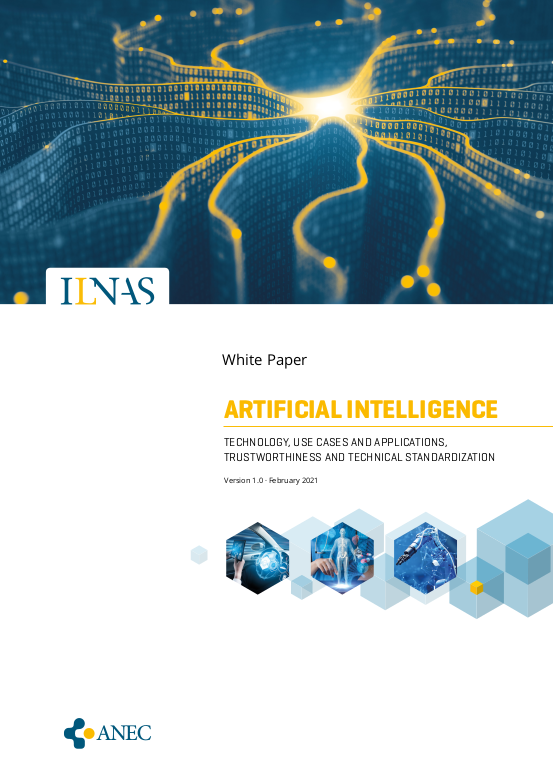Commission Nationale de Normalisation ILNAS/NSC 04 "Artificial Intelligence"

Le Luxembourg est activement impliqué dans la normalisation technique du domaine "Artificial Intelligence and Big data" via son implication au sein de différents comités techniques aux niveaux européens et international, dont les travaux sont suivis au sein de la Commission Nationale de Normalisation ILNAS/NSC 04 "Artificial Intelligence".
Cette commission offre aux acteurs du marché luxembourgeois une plateforme unique permettant de suivre et de participer aux activités de normalisation du domaine. Ils peuvent ainsi apporter leur expertise au développement mondial de la normalisation pour l'intelligence artificielle. Tout acteur national intéressé peut enregistrer des délégués nationaux en normalisation au sein de la commission pour participer à ces travaux.
L'ensemble des délégués nationaux en normalisation inscrits au sein de la Commission Nationale de Normalisation ILNAS/NSC 04 "Artificial Intelligence" sont enregistrés dans le registre national des délégués. La commission donne accès aux travaux des comités techniques de normalisation suivants :
ISO/IEC JTC 1/SC 42 Artificial intelligence
Le sous-comité technique ISO/IEC JTC 1/SC 42 Artificial Intelligence, dont le Luxembourg est membre participant, développe des normes dans le domaine de l’intelligence artificielle et couvre les différents aspects de la technologie :
- Les fondations : terminologie, cadre d'apprentissage automatique,
- La gouvernance et le système de gestion de l’IA,
- Données,
- Fiabilité,
- Cas d’utilisation et applications,
- Caractéristiques systémiques et algorithmes pour la mise en œuvre de l'intelligence artificielle.
Le programme de travail ainsi qu’une liste des normes déjà publiées de sous-comité peuvent être consultés sur les pages dédiées.
CEN/CLC JTC 21 Artificial Intelligence
Le comité technique CEN/CLC JTC 21 est en charge de la production de livrables de normalisation dans le domaine de l'intelligence artificielle et de l'utilisation connexe des données, et fournit des orientations aux autres comités techniques européens concernés par l'intelligence artificielle. Le comité examine également la possibilité d'adopter des normes d'autres organisations pertinentes, par exemple en provenance de l’ISO/IEC JTC 1/SC 42. Le comité produit avant tout des livrables de normalisation pour répondre aux besoins du marché européen et pour étayer la législation, les politiques, les principes et les valeurs de l'Union Européenne.
Le programme de travail du comité est disponible sur le site du CEN-CENELEC.
Autres travaux de normalisation dans le domaine de l'intelligence artificielle
L’attention est également portée aux développements normatifs de l’ETSI (European Telecommunications Standards Institute) et de l’ITU-T (l’union internationale des télécommunications).
ETSI ISG Securing AI
L'ISG SAI (Industry Specification Group Securing Artificial Intelligence) élabore des spécifications techniques qui permettent d’atténuer les menaces pesant sur les systèmes d'IA, provenant à la fois d'autres IA et de sources conventionnelles.
L'ISG SAI aborde 3 aspects principaux de la normalisation de la sécurité de l'IA :
- Sécuriser l'IA contre les attaques, par ex. où l'IA est un composant d’un système qui doit être défendu.
- Protection contre l'IA, par ex. où l'attaque vient de l’IA ou l’IA est utilisée pour améliorer et renforcer les mécanismes d'attaque plus conventionnels,
- Utiliser l'IA pour améliorer les mesures de sécurité contre les attaques, par ex. l'IA fait partie de la « solution » ou est utilisée pour améliorer et renforcer des contre-mesures plus conventionnelles).
Une liste des spécifications publiées est disponible dans le registre des normes disponibles. Le programme de travail peut être consulté depuis le portail dédié du groupe. Concernant l’utilisation de l’IA dans d’autres secteurs, par exemple dans le réseau de télécommunication ou encore dans la santé, l’ETSI a publié un white paper on AI standardization activities within ETSI.
ITU-T
L’ITU-T considère l’utilisation et l’impact de l’IA dans différents domaines et fournit des recommandations dédiées principalement à travers les Focus Groups. Parmi les groupes actuels se trouvent :
- ITU-T Focus Group on "Artificial Intelligence (AI) and Internet of Things (IoT) for Digital Agriculture" (FG-AI4A)
- ITU-T Focus Group on AI for Natural Disaster Management (FG-AI4NDM)
- ITU-T Focus Group on "Artificial Intelligence for Health" (FG-AI4H)
Activités de l'ILNAS dans le domaine Artificial Intelligence
White Paper « Artificial Intelligence - Technology, Use Cases and Applications, Trustworthiness and Technical Standardization »
 |
Le White Paper « Artificial Intelligence - Technology, Use Cases and Applications, Trustworthiness and Technical Standardization » a été publié par l'ILNAS en février 2021. Il introduit les notions clés pour comprendre l'intelligence artificielle et ses défis de manière accessible. La normalisation technique sert de fil d’Ariane pour présenter et relever ces défis tout au long du document. L’intelligence artificielle y est abordée selon quatre axes complémentaires : Une présentation du contexte historique et actuel, une introduction technique qui établit les concepts fondamentaux de l’intelligence artificielle, une analyse des domaines d’application de l’intelligence artificielle et une vue d’ensemble sur des questions de fiabilité de l’intelligence artificielle. |
Formation AI Standards watch: standards relevant to the proposed AI Act
L'ILNAS, avec le support de l'ANEC GIE, propose une formation AI Standards watch: standards relevant to the proposed AI Act. Elle donne un aperçu des normes introduites dans la veille normative préparée par le Centre commun de recherche (JRC, Joint Research Center) en lien avec la proposition de projet de réglement sur l'IA de l'UE, et se concentre sur les normes principales identifiées. Ainsi, les participants pourront en savoir plus sur le contenu de ces normes et, si nécessaire, planifier leur implication dans les projets de normes qui sont encore en développement.
Workshop: Artificial intelligence and technical standardization
L'ILNAS, avec le support de l'ANEC GIE, propose un atelier Artificial intelligence and technical standardization. Il vise à sensibiliser les participants à l'importance de la normalisation technique dans le domaine des technologies de l'information et de la communication, en particulier dans le domaine de l'intelligence artificielle (IA). Au cours de l'atelier, les participants développeront des applications d'IA (par exemple, classification d'images, reconnaissance faciale) dans des ressources en nuage, où ils pourront appliquer concrètement la normalisation technique à l'aide de cas d'utilisation pratiques.

